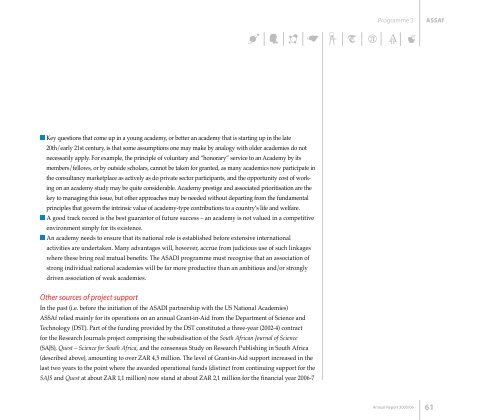Academy of Science South Africa 2005/6 Annual Report
Academy of Science South Africa 2005/6 Annual Report
Academy of Science South Africa 2005/6 Annual Report
- No tags were found...
You also want an ePaper? Increase the reach of your titles
YUMPU automatically turns print PDFs into web optimized ePapers that Google loves.
Programme 3ASSAfKey questions that come up in a young academy, or better an academy that is starting up in the late20th/early 21st century, is that some assumptions one may make by analogy with older academies do notnecessarily apply. For example, the principle <strong>of</strong> voluntary and “honorary” service to an <strong>Academy</strong> by itsmembers/fellows, or by outside scholars, cannot be taken for granted, as many academics now participate inthe consultancy marketplace as actively as do private sector participants, and the opportunity cost <strong>of</strong> workingon an academy study may be quite considerable. <strong>Academy</strong> prestige and associated prioritisation are thekey to managing this issue, but other approaches may be needed without departing from the fundamentalprinciples that govern the intrinsic value <strong>of</strong> academy-type contributions to a country’s life and welfare.A good track record is the best guarantor <strong>of</strong> future success – an academy is not valued in a competitiveenvironment simply for its existence.An academy needs to ensure that its national role is established before extensive internationalactivities are undertaken. Many advantages will, however, accrue from judicious use <strong>of</strong> such linkageswhere these bring real mutual benefits. The ASADI programme must recognise that an association <strong>of</strong>strong individual national academies will be far more productive than an ambitious and/or stronglydriven association <strong>of</strong> weak academies.Other sources <strong>of</strong> project supportIn the past (i.e. before the initiation <strong>of</strong> the ASADI partnership with the US National Academies)ASSAf relied mainly for its operations on an annual Grant-in-Aid from the Department <strong>of</strong> <strong>Science</strong> andTechnology (DST). Part <strong>of</strong> the funding provided by the DST constituted a three-year (2002-4) contractfor the Research Journals project comprising the subsidisation <strong>of</strong> the <strong>South</strong> <strong>Africa</strong>n Journal <strong>of</strong> <strong>Science</strong>(SAJS), Quest – <strong>Science</strong> for <strong>South</strong> <strong>Africa</strong>, and the consensus Study on Research Publishing in <strong>South</strong> <strong>Africa</strong>(described above), amounting to over ZAR 4,5 million. The level <strong>of</strong> Grant-in-Aid support increased in thelast two years to the point where the awarded operational funds (distinct from continuing support for theSAJS and Quest at about ZAR 1,1 million) now stand at about ZAR 2,1 million for the financial year 2006-7<strong>Annual</strong> <strong>Report</strong> <strong>2005</strong>/0661









![National Research Foundation Annual Report 2008 / 2009 [Part 2]](https://img.yumpu.com/49774036/1/177x260/national-research-foundation-annual-report-2008-2009-part-2.jpg?quality=85)






